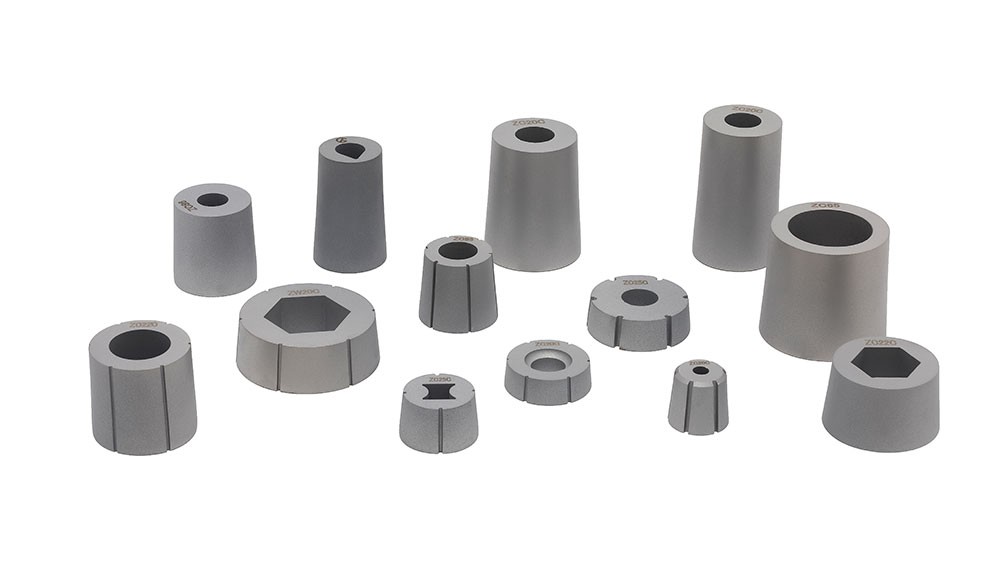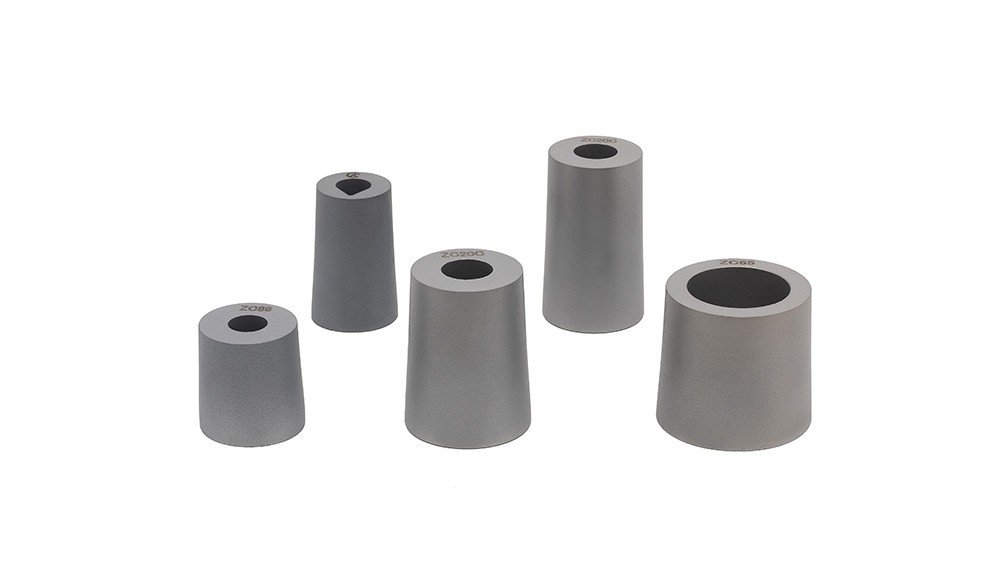E-mail: ping.wu@cszccarbide.com
Location:No.4 Xiaoshanjing Road, Zhitang Town, Changshu City, Jiangsu Province, China




上一张
下一张
| Brand comparison | Density g/cm3 ±0.1 | HRA ±0.5 | TRS N/mm2 | use | ||||
| Variety differentiation | ZCCF brand | * | * | * | ||||
| For wear-resistant tools | ZW4G |
|
KG05 |
|
15.00 | 93.00 | 2900 | Drawing tube, drawing wire, shrinking tube, wear-resistant and spinning die, powder metallurgy, etc. |
| ZW4T |
|
|
|
15.10 | 93.80 | 2800 | ||
| ZW6G | G2 | KG1 | C01 | 14.90 | 92.00 | 3000 | ||
| ZW6T |
|
|
|
14.95 | 92.80 | 2900 | ||
| ZW06 | G2 | KG2 | C02 | 14.98 | 91.00 | 3500 | ||
| ZW08 | G3 | KG3 | C03 | 14.75 | 90.00 | 3400 | ||
| ZW10 | G4 |
|
|
14.60 | 89.50 | 3600 | ||
| ZW12 | G5 | KG5 | S155 | 14.40 | 88.50 | 3800 | Wear-resistant and impact-resistant die, etc Example :cutting die, strong beam die for screws, etc. | |
| ZW14 | G6 | KG6 | E36 | 14.10 | 87.50 | 3500 | ||
| ZW70 |
|
|
|
14.07 | 87.00 | 3600 | Beam rod, stretching | |
| ZW16 | CD650 | KG7 |
|
13.85 | 89.00 | 4100 | Stamping die, drawing/forming die for all kinds of sheet | |
| For impact-resistant tools | ZW18C |
|
KE18 |
|
13.60 | 83.50 | 2800 | Screw die all tungsten one punch, etc |
| ZW15C |
|
VA70 | C27 | 14.00 | 86.50 | 2900 | Impact-resistant forging die, drawing tooth die, etc | |
| ZW20C | G7 | VA80 | C28 | 13.55 | 84.40 | 3200 | Screw die, six-piece die, nut die, cutting die, etc | |
| ZW22C |
|
VA90 | E55 | 13.36 | 83.50 | 2600 | Nut die, wire cutting die, punching die, etc | |
| ZW25C |
|
VA95 | C11 | 13.10 | 81.00 | 2800 | Impact-resistant forging die, nut die: used for sleeve, etc | |
| ZW27C |
|
|
|
12.95 | 80.00 | 2900 | Large flange | |
| ZC18C |
|
ST-6 | SI65 | 13.60 | 86.50 | 3200 | Tin screw die, general straight hole die, triangular main die, etc | |
| ZC20C |
|
ST-7 |
|
13.50 | 85.50 | 3200 | Nut die, screw die, etc | |
| ZC20 | G7 |
|
E40 | 13.38 | 86.30 | 3200 | ||
| ZC22C |
|
|
|
13.18 | 84.50 | 2860 | ||
| ZC25C |
|
|
|
13.05 | 82.50 | 2800 | Tin nut die, screw die, etc | |
| ZB18 |
|
EA65 |
|
13.70 | 84.50 | 2900 | Ordinary screw die | |
| ZB20C | G7 | ST-1 |
|
13.45 | 84.40 | 3000 | Screw die and stainless steel screw die and dishes | |
| ZW23 |
|
|
SI85 | 13.25 | 84.10 | 3000 | Tooth die, large flange, six-piece die | |
| ZC23C |
|
|
|
13.17 | 83.50 | 2700 | Stainless steel screws die, nut die | |
| ZW80 |
|
|
|
13.09 | 84.20 | 2800 | Flower tooth die, head forming die | |
| ultramicron | HZ88 | ZN01 | WF15 | ultramicron | 14.40 | 92.00 | 3300 | Steel, cast iron drill, reamer and other cutting tools tungsten steel punch rod |
| HZ86 | ZN15 | WF20 | ultramicron | 14.15 | 91.50 | 3600 | ||
| ZW30 |
|
|
ultramicron | 14.05 | 91.00 | 3300 | ||
| For heat-resistant tools | HZ40 |
|
HA60 | Heat resistance | 13.97 | 84.80 | 2690 | Hot extrusion die, hot forging die, etc |
| ZW40 |
|
|
Heat resistance | 14.25 | 86.00 | 2600 | ||
| HZ60 |
|
|
Heat resistance | 13.42 | 82.50 | 2800 | ||
| HZ65 |
|
|
Heat resistance | 13.40 | 85.00 | 2900 | ||
| HZ70 |
|
|
Heat resistance | 13.45 | 84.50 | 3000 | ||
| A new generation of high abrasion resistance, high impact-resistance cold heading, cold forging die | ZC50 |
|
|
|
13.88 | 89.50 | 3800 | Stretching die, strong beam die |
| ZC60 |
|
|
|
13.78 | 86.50 | 3300 | stretching and shrinking die | |
| ZC65 |
|
|
|
13.90 | 87.50 | 3400 | ||
| ZC68 |
|
|
|
13.85 | 86.50 | 3450 | ||
| ZC70 |
|
|
|
13.80 | 88.00 | 3400 | ||
| ZC85 |
|
|
|
13.10 | 83.60 | 2700 | Large flange, head forming die, six-piece die | |
| ZC86 |
|
|
|
13.30 | 84.00 | 2860 | Flower tooth belt rod | |
| ZC89 |
|
|
|
13.05 | 83.00 | 2900 | Screw die and stainless steel screw die and dish die | |
 Raw material
Raw material
 dosing
dosing
 mixed
mixed
 Press forming
Press forming
 Pressure sintering
Pressure sintering
 Product inspection
Product inspection

The specific gravity of cemented carbide decreases with the increase of drill content, and the grain size of tungsten carbide does not affect the specific gravity value.
When cemented carbide is used in different temperature environments, the coefficient of thermal expansion is a very important factor. When cemented carbide is welded with other materials like steel, cracks often occur. This crack is caused by different coefficient of thermal expansion. The coefficient of thermal expansion of cemented carbide should be 1/2-1/3 of steel. The coefficient of thermal expansion increases with the increase of drill content.
At high temperatures, the coefficient of thermal conductivity is as important as the coefficient of thermal expansion. The thermal conductivity of cemented carbide with tungsten carbide and drill particles is twice as big as that of steel and decreases with the increase of drill content.
Although carbides such as tungsten carbide are non-magnetic, its metal complexes, such as diamonds, are magnetic. Therefore, it is affected by the amount of metal it binds. However, non-magnetic alloys can be obtained by changing the composition of the alloy, for example, when nickel is added as a binding metal, its magnetic permeability is approximately 1.
In the high temperature atmosphere (oxidation) environment, cemented carbide is easy to produce quality degradation and other problems due to oxidation. In the oxidizing environment, the bonded metal is first oxidized at low temperatures, and tungsten carbide also begins to oxidize when the temperature exceeds 700°C. Therefore, the composition and quantity of the combined metal in the temperature range below 700°C determines the oxidation control factors. In the field of high temperature at 700°C, adding Tic, Tac and other carbides to adjust the grain size of WC is an effective control method.
Cemented carbide shows different corrosion phenomena in different use environments (temperature, humidity, solution, various types of bonded metals, electrical energy, etc., all affect corrosion factors). The strength of the material is weakened due to local corrosion. Therefore, it is very necessary to understand the factors that produce corrosion in different environments. As for the corrosion resistance of cemented carbide, metal bonding is significant.
Porosity indicates the state of fine empty holes in the polished surface microstructure of the cemented carbide. In the cemented carbide made of powder metallurgy, the porosity sometimes causes the alloy strength degradation and surface defects. In order to suppress and eliminate pores, our company constantly takes measures to improve systems and processes. Pressure sintering furnace, hot isostatic pressing sintering and hot isostatic pressing device have been developed. The porosity has passed the Superhard Tool Association standard and CS-006B standard test (cemented carbide porosity classification standard) for high-precision detection.
Here are the classification guidelines:
Class A: Porosity is less than 10um, divided into A02-08 four grades qualified range: below A02 Class B: porosity is 10-14um, divided into B02-08 four grades qualified range: below B02.
Class C: Free carbon porosity is divided into four grades of CO2-08, and the qualified range is below CO2.